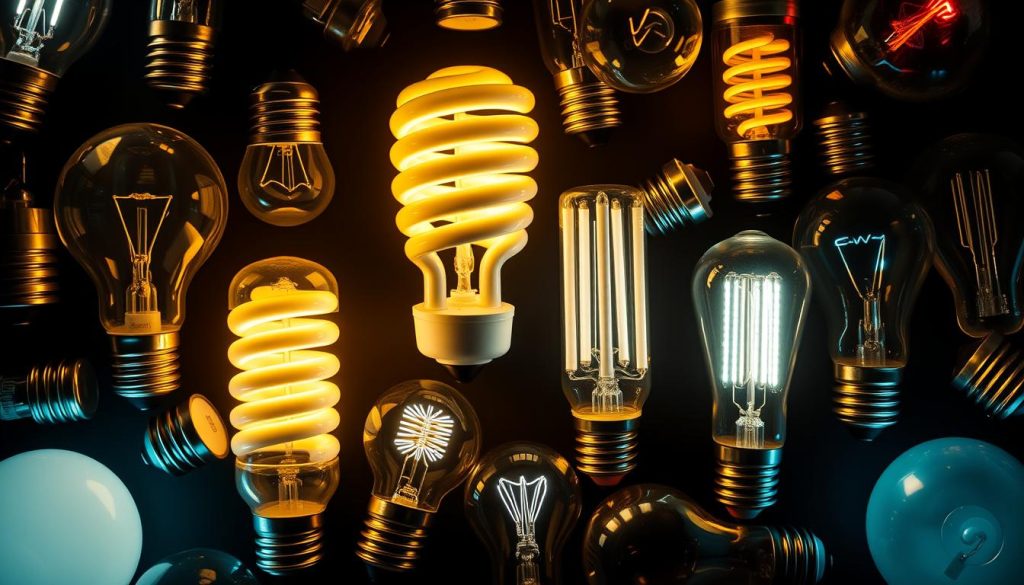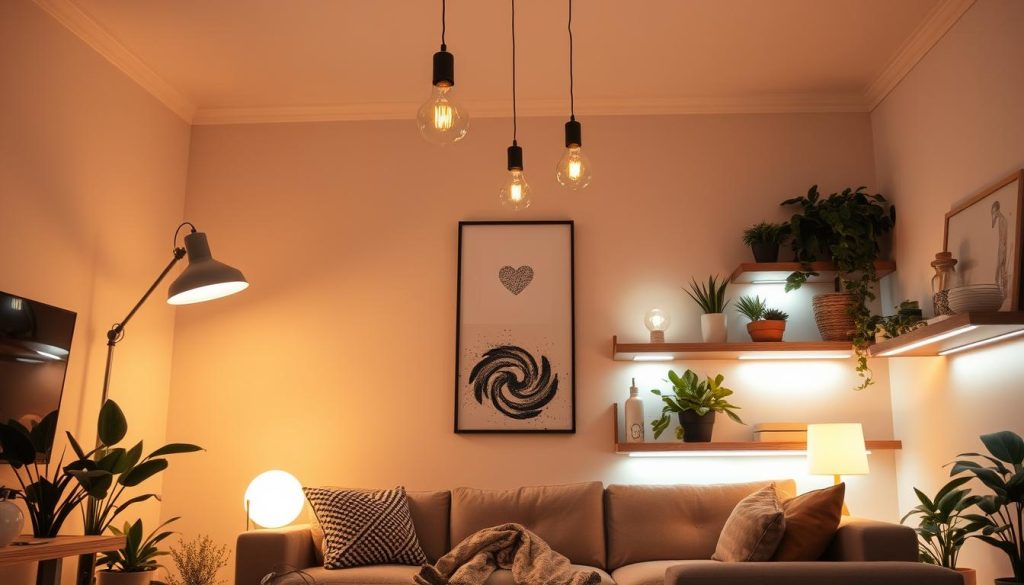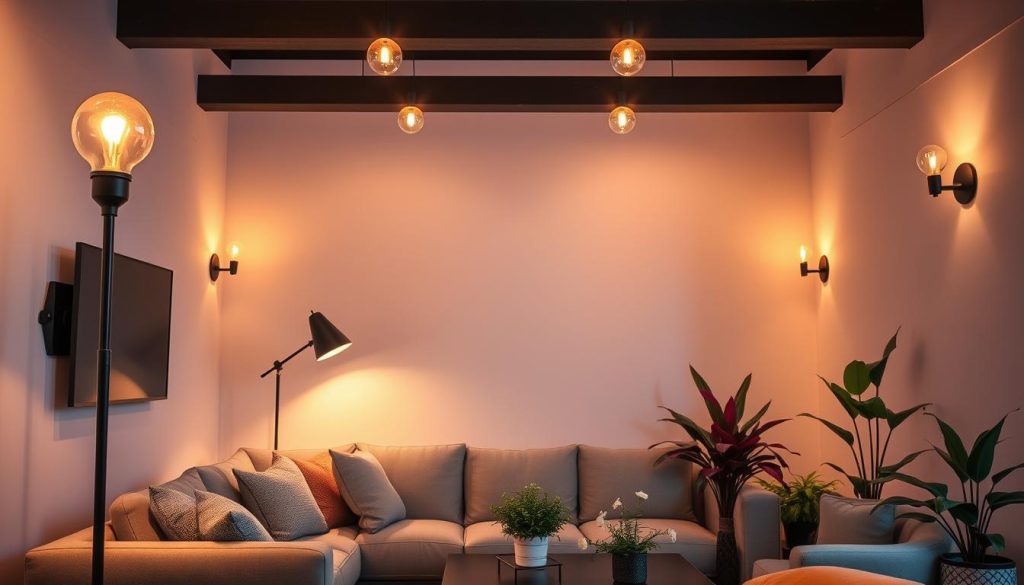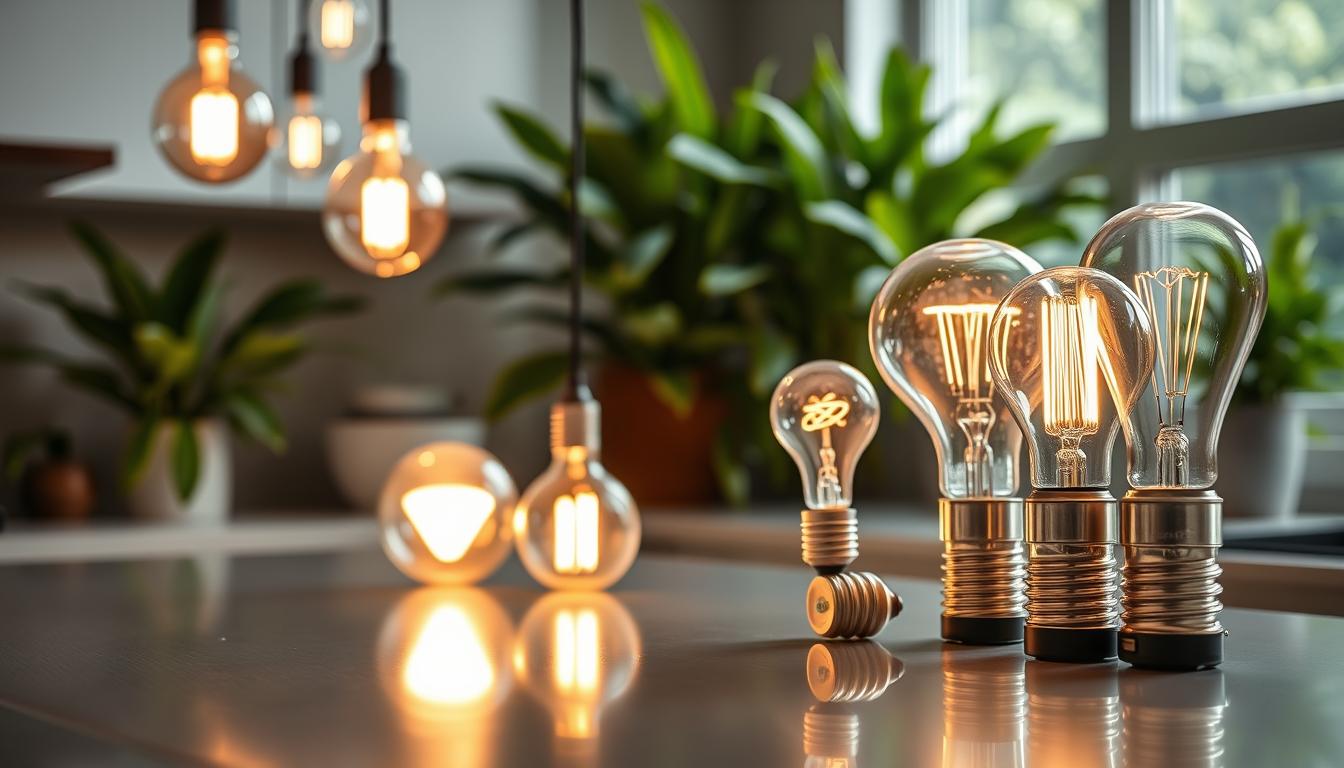I started looking for ways to cut down on my utility bills. That’s when I found out about energy-efficient light bulbs. I was surprised at how much of a difference they made in my home’s energy use.
Switching to these bulbs helped me save a lot on my energy bills. It also reduced my carbon footprint. It was a win-win situation.
Now, energy-efficient light bulbs are a big part of my life. I’m eager to share what I’ve learned with others. In this article, I’ll talk about the benefits of these bulbs. They save energy and money.
Why I Chose Energy-Efficient Light Bulbs
I chose energy-efficient light bulbs for my home because of their many benefits. They are great for the environment, which is important to me. Plus, they help save money on my energy bills.
Energy-efficient bulbs have several advantages:
- They use less energy.
- They cost less to use.
- They last longer than regular bulbs.
When picking energy-efficient bulbs, think about how bright and warm they are. There are many styles to choose from, for any room. Switching to these bulbs has helped me use less energy and support a greener future.
Understanding Different Types of Energy-Efficient Light Bulbs

There are many energy-efficient lighting options out there. Each type has its own benefits and features. Let’s explore CFLs, LEDs, and Halogen Incandescents to help you choose the best one for you.
Compact Fluorescent Lamps (CFLs)
CFLs are a top pick for saving energy. They use less power than old bulbs and last longer. Plus, they’re easy on your wallet.
Light Emitting Diodes (LEDs)
LED bulbs are super efficient and last a long time. They help cut down on energy costs and are good for the planet. You can find them in many colors and they can be dimmed too.
Halogen Incandescents
Halogen bulbs are another energy-saving choice. They use a special gas to make them last longer. They give off a warm light but aren’t as efficient as CFLs or LEDs.
Let’s compare the energy-efficient bulbs:
| Type of Bulb | Energy Consumption | Lifespan | Cost |
|---|---|---|---|
| CFLs | Low | 8,000-10,000 hours | Relatively inexpensive |
| LEDs | Very Low | 25,000-50,000 hours | More expensive than CFLs |
| Halogen Incandescents | Medium | 2,000-4,000 hours | Relatively inexpensive |
In conclusion, think about energy use, lifespan, and cost when picking bulbs. The right choice can save you money and help the planet. Plus, you get to enjoy the benefits of energy-efficient lighting.
How Energy-Efficient Light Bulbs Work
I got really interested in how energy-efficient bulbs work. These bulbs, like CFLs and LEDs, change how we light our spaces. They use less energy and last longer than old bulbs.
These bulbs are cool because they use less energy to light up. They do this by losing less heat and making more light. CFLs use a special gas to light up a phosphor coating. LEDs, on the other hand, use semiconductors to light up when electricity flows through them.
The Technology Behind CFLs
- CFLs use a gas-filled tube that excites a phosphor coating to produce light
- They are more energy-efficient than traditional incandescent bulbs and have a longer lifespan
- CFLs are available in a range of colors and can be used in a variety of fixtures
The Mechanism of LEDs
LEDs work by using semiconductors to light up when electricity flows through them. This makes them very energy-efficient and long-lasting. Now, we can find bulbs that are good for the planet and save money too.
My Experience with the Transition to Energy-Efficient Bulbs

I started my journey to make my home more eco-friendly by looking into green lighting options. I switched from incandescent bulbs to energy-efficient ones. This change cut down my carbon footprint and saved me money on energy bills.
I first replaced my old bulbs with compact fluorescent lamps (CFLs). But then, I found out about light emitting diodes (LEDs). LEDs were even better, lasting longer and using less energy. I chose LEDs for my whole house because of their eco-friendly benefits.
The Switch from Incandescent to CFLs
Switching to CFLs was easy. I just swapped out the old bulbs for new CFLs and saw my energy use drop. But CFLs had some downsides, like taking longer to warm up and not having the best color.
Discovering the Advantages of LEDs
LEDs blew me away with their performance. They lit up fast, had better color options, and lasted a long time. Plus, they’re free from harmful chemicals like mercury. LEDs helped me make my home lighting more efficient and cozy.
In the end, switching to energy-efficient bulbs was a great choice. LEDs helped me save energy, cut down on bills, and make my home greener. If you’re thinking about making the switch, look into the different green lighting options. Find the one that fits your needs best.
The Financial Savings from Energy-Efficient Lighting
Energy-efficient lighting offers a big financial advantage. Although these bulbs cost more upfront, they save a lot on energy bills over time. They can last up to 25 times longer than old bulbs, cutting down on replacement costs.
Switching to energy-saving bulbs can lower your utility bills. Here are some tips to get the most savings:
- Look for rebates and incentives from local utilities or government agencies.
- Choose bulbs with high lumens per watt for better energy savings.
- Install smart lighting systems to use energy more wisely.
Switching to energy-efficient bulbs and using available incentives can save you money. It also helps the environment. With the right choices, you can make your home more energy-efficient and cost-effective.
| Type of Bulb | Energy Consumption | Lifespan |
|---|---|---|
| Incandescent | 60 watts | 1,000 hours |
| Energy-efficient | 9 watts | 25,000 hours |
Choosing the Right Energy-Efficient Light Bulb for My Needs

Choosing the right energy-efficient light bulb is important for my home. I start by thinking about how bright I want the light to be and its color. In my living room, I like warm white LED bulbs for a cozy feel. But in the kitchen, cool white bulbs are better for tasks.
I do my homework on different energy-saving bulbs. I look for those with the Energy Star label, showing they’re energy-efficient. I also check the lumen output to ensure the bulb is bright enough.
- LED light bulbs with a high lumen output
- Low energy consumption bulbs with a long lifespan
- Smart light bulbs that can be controlled remotely
When buying energy-efficient bulbs, I check online stores or local hardware shops. Brands like Philips, LIFX, and GE are popular. By picking the right bulb, I save energy and help the planet.
Tips for Maximizing the Lifespan of My Light Bulbs
To get the most out of my energy-efficient light bulbs, I’ve learned a few valuable tips. Proper handling and installation are key to making them last longer. When installing new bulbs, I handle them carefully to avoid damage.
Some important tips for extending bulb life include avoiding extreme temperatures and keeping them clean. Also, using them in suitable fixtures is crucial. These steps help me enjoy sustainable lighting while saving energy and money.
Here are some additional tips for extending the life of my energy-efficient light bulbs:
- Avoid exposing them to moisture or water
- Use a soft cloth to clean any dust or debris
- Replace them immediately if I notice any signs of wear or damage
By following these simple steps, I can ensure my energy-efficient light bulbs provide reliable lighting for years.
Future Trends in Energy-Efficient Lighting
The world is moving towards moreeco-friendly lightingoptions. I’m excited about the newenergy-efficient home lightingtechnologies. Smart lighting systems are becoming popular. They let homeowners control theirgreen lightingremotely, saving energy and money.
Smart home automation withenergy-efficient light bulbsis really interesting. By using LED bulbs or othereco-friendly lightingwith voice control or apps, I can make my lighting more efficient. This saves me money and helps the planet.
As people want moreenergy-efficient home lighting, we’ll see even more new ideas. We’ll see better sensors and more use of renewable energy. The future ofgreen lightinglooks very promising.

